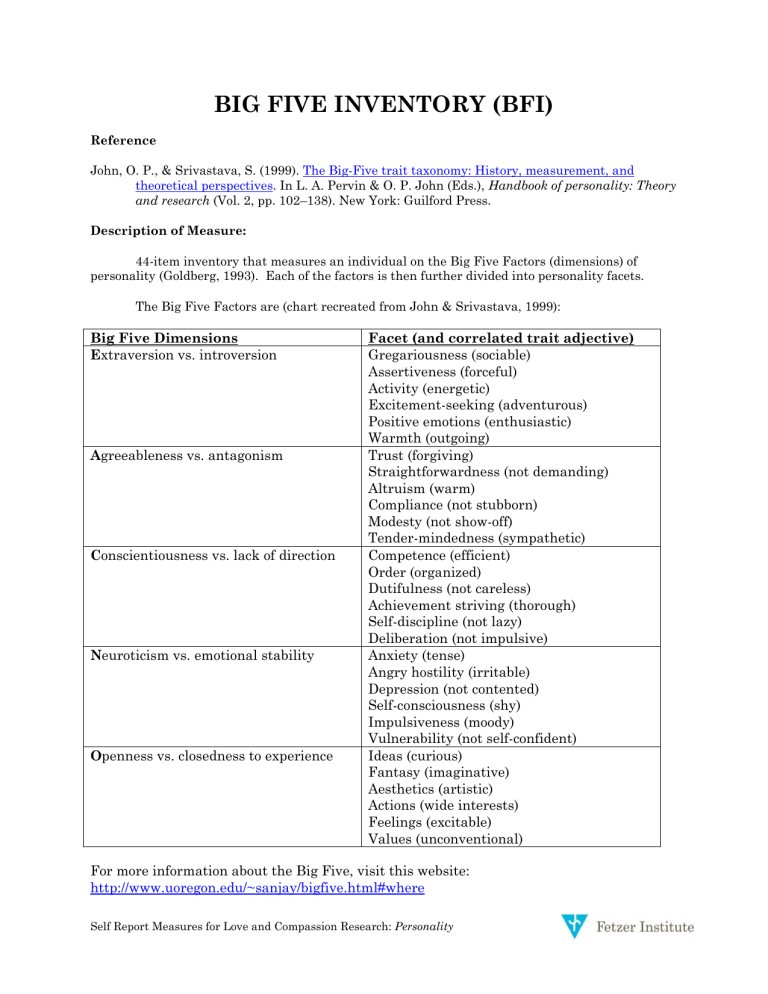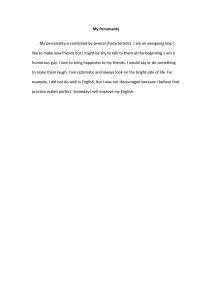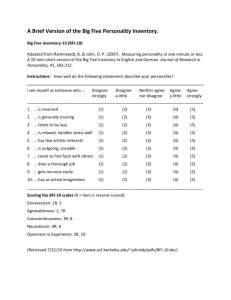
BIG FIVE INVENTORY (BFI) Reference John, O. P., & Srivastava, S. (1999). The Big-Five trait taxonomy: History, measurement, and theoretical perspectives. In L. A. Pervin & O. P. John (Eds.), Handbook of personality: Theory and research (Vol. 2, pp. 102–138). New York: Guilford Press. Description of Measure: 44-item inventory that measures an individual on the Big Five Factors (dimensions) of personality (Goldberg, 1993). Each of the factors is then further divided into personality facets. The Big Five Factors are (chart recreated from John & Srivastava, 1999): Big Five Dimensions Extraversion vs. introversion Agreeableness vs. antagonism Conscientiousness vs. lack of direction Neuroticism vs. emotional stability Openness vs. closedness to experience Facet (and correlated trait adjective) Gregariousness (sociable) Assertiveness (forceful) Activity (energetic) Excitement-seeking (adventurous) Positive emotions (enthusiastic) Warmth (outgoing) Trust (forgiving) Straightforwardness (not demanding) Altruism (warm) Compliance (not stubborn) Modesty (not show-off) Tender-mindedness (sympathetic) Competence (efficient) Order (organized) Dutifulness (not careless) Achievement striving (thorough) Self-discipline (not lazy) Deliberation (not impulsive) Anxiety (tense) Angry hostility (irritable) Depression (not contented) Self-consciousness (shy) Impulsiveness (moody) Vulnerability (not self-confident) Ideas (curious) Fantasy (imaginative) Aesthetics (artistic) Actions (wide interests) Feelings (excitable) Values (unconventional) For more information about the Big Five, visit this website: http://www.uoregon.edu/~sanjay/bigfive.html#where Self Report Measures for Love and Compassion Research: Personality Abstracts of Selected Related Articles: Bouchard, T. J. & McGue, M. (2003). Genetic and environmental influences on human psychological differences. Journal of Neurobiology, 54, 4-45. Psychological researchers typically distinguish five major domains of individual differences in human behavior: cognitive abilities, personality, social attitudes, psychological interests, and psychopathology (Lubinski, 2000). In this article we: discuss a number of methodological errors commonly found in research on human individual differences; introduce a broad framework for interpreting findings from contemporary behavioral genetic studies; briefly outline the basic quantitative methods used in human behavioral genetic research; review the major criticisms of behavior genetic designs, with particular emphasis on the twin and adoption methods; describe the major or dominant theoretical scheme in each domain; and review behavioral genetic findings in all five domains. We conclude that there is now strong evidence that virtually all individual psychological differences, when reliably measured, are moderately to substantially heritable. Tkach, C., & Lyubomirsky, S. (2006). How do people pursue happiness?: Relating personality, happiness-increasing strategies, and well-being. Journal of Happiness Studies, 7, 183-225. Five hundred ethnically diverse undergraduates reported their happiness strategies – that is, activities undertaken to maintain or increase happiness. Factor analysis extracted eight general strategies: Affiliation, Partying, Mental Control, Goal Pursuit, Passive Leisure, Active Leisure, Religion, and Direct Attempts at happiness. According to multiple regression analyses, these strategies accounted for 52% of the variance in self-reported happiness and 16% over and above the variance accounted for by the Big Five personality traits. The strongest unique predictors of current happiness were Mental Control (inversely related), Direct Attempts, Affiliation, Religion, Partying, and Active Leisure. Gender differences suggest that men prefer to engage in Active Leisure and Mental Control, whereas women favor Affiliation, Goal Pursuit, Passive Leisure, and Religion. Relative to Asian and Chicano(a) students, White students preferred using high arousal strategies. Finally, mediation analyses revealed that many associations between individuals’ personality and happiness levels are to some extent mediated by the strategies they use to increase their happiness – particularly, by Affiliation, Mental Control, and Direct Attempts. Shiota, M.N., Keltner, D., & John, O. P. (2006). Positive emotion dispositions differentially associated with Big Five personality and attachment style. The Journal of Positive Psychology, 1, 61-71. Although theorists have proposed the existence of multiple distinct varieties of positive emotion, dispositional positive affect is typically treated as a unidimensional variable in personality research. We present data elaborating conceptual and empirical differences among seven positive emotion dispositions in their relationships with two core personality constructs, the ‘‘Big Five’’ and adult attachment style. We found that the positive emotion dispositions were differentially associated with self- and peer-rated Extraversion, Conscientiousness, Agreeableness, Openness to Experience, and Neuroticism. We also found that different adult attachment styles were associated with different kinds of emotional rewards. Findings support the theoretical utility of differentiating among several dispositional positive emotion constructs in personality research. Self Report Measures for Love and Compassion Research: Personality Scale: The Big Five Inventory (BFI) Here are a number of characteristics that may or may not apply to you. For example, do you agree that you are someone who likes to spend time with others? Please write a number next to each statement to indicate the extent to which you agree or disagree with that statement. Disagree strongly 1 Disagree a little 2 Neither agree nor disagree 3 Agree a little 4 Agree Strongly 5 I see Myself as Someone Who... ____1. Is talkative ____23. Tends to be lazy ____2. Tends to find fault with others ____24. Is emotionally stable, not easily upset ____3. Does a thorough job ____25. Is inventive ____4. Is depressed, blue ____26. Has an assertive personality ____5. Is original, comes up with new ideas ____27. Can be cold and aloof ____6. Is reserved ____28. Perseveres until the task is finished ____7. Is helpful and unselfish with others ____29. Can be moody ____8. Can be somewhat careless ____30. Values artistic, aesthetic experiences ____9. Is relaxed, handles stress well ____31. Is sometimes shy, inhibited ____10. Is curious about many different things ____32. Is considerate and kind to almost everyone ____11. Is full of energy ____33. Does things efficiently ____12. Starts quarrels with others ____34. Remains calm in tense situations ____13. Is a reliable worker ____35. Prefers work that is routine ____14. Can be tense ____36. Is outgoing, sociable ____15. Is ingenious, a deep thinker ____37. Is sometimes rude to others ____16. Generates a lot of enthusiasm ____38. Makes plans and follows through with them ____17. Has a forgiving nature ____39. Gets nervous easily ____18. Tends to be disorganized ____40. Likes to reflect, play with ideas ____19. Worries a lot ____41. Has few artistic interests Self Report Measures for Love and Compassion Research: Personality ____20. Has an active imagination ____42. Likes to cooperate with others ____21. Tends to be quiet ____43. Is easily distracted ____22. Is generally trusting ____44. Is sophisticated in art, music, or literature Scoring: BFI scale scoring (“R” denotes reverse-scored items): Extraversion: 1, 6R, 11, 16, 21R, 26, 31R, 36 Agreeableness: 2R, 7, 12R, 17, 22, 27R, 32, 37R, 42 Conscientiousness: 3, 8R, 13, 18R, 23R, 28, 33, 38, 43R Neuroticism: 4, 9R, 14, 19, 24R, 29, 34R, 39 Openness: 5, 10, 15, 20, 25, 30, 35R, 40, 41R, 44 Self Report Measures for Love and Compassion Research: Personality




